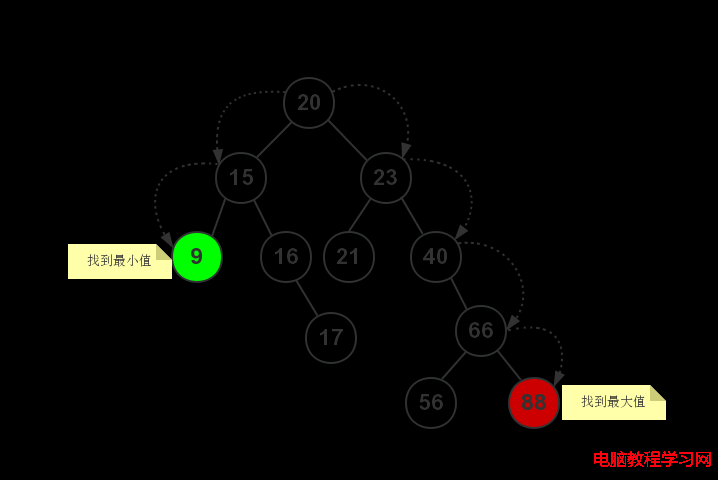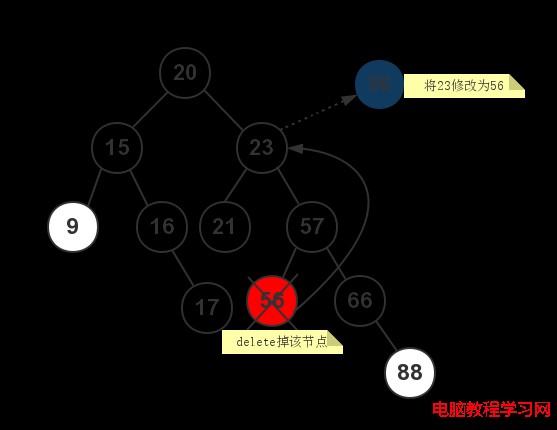在數據結構中,有一個奇葩的東西,說它奇葩,那是因為它重要,這就是樹。而在樹中,二叉樹又是當中的貴族。二叉樹的一個重要應用是它們在查找中的應用,於是就有了二叉查找樹。 使二叉樹成為一顆二叉查找樹,需要滿足以下兩點:
以下是對於二叉查找樹的基本操作定義類,然後慢慢分析是如何實現它們的。
template<class T>class BinarySearchTree{public:
// 構造函數,初始化root值
BinarySearchTree() : root(NULL){}
// 析構函數,默認實現
~BinarySearchTree() {}
// 查找最小值,並返回最小值
const T &findMin() const;
// 查找最大值,並返回最大值
const T &findMax() const;
// 判斷二叉樹中是否包含指定值的元素
bool contains(const T &x) const;
// 判斷二叉查找樹是否為空
bool isEmpty() const { return root ? false : true; }
// 打印二叉查找樹的值
void printTree() const;
// 向二叉查找樹中插入指定值
void insert(const T &x);
// 刪除二叉查找樹中指定的值
void remove(const T &x);
// 清空整個二叉查找樹
void makeEmpty() const;private:
// 指向根節點
BinaryNode<T> *root;
void insert(const T &x, BinaryNode<T> *&t) const;
void remove(const T &x, BinaryNode<T> *&t) const;
BinaryNode<T> *findMin(BinaryNode<T> *t) const;
BinaryNode<T> *findMax(BinaryNode<T> *t) const;
bool contains(const T &x, BinaryNode<T> *t) const;
void printTree(BinaryNode<T> *t) const;
void makeEmpty(BinaryNode<T> *&t) const;};根據二叉查找樹的性質:
我們可以從root節點開始:
NULL為止,這樣就可以找到最小值了;NULL為止,這樣就可以找到最大值了。如下圖所示: 
在程序中實現時,有兩種方法:
對於finMin的實現,我這裡使用遞歸的方式,代碼參考如下:
BinaryNode<T> *BinarySearchTree<T>::findMin(BinaryNode<T> *t) const{
if (t == NULL)
{
return NULL;
}
else if (t->left == NULL)
{
return t;
}
else
{
return findMin(t->left);
}}在findMin()的內部調用findMin(BinaryNode<T> *t),這樣就防止了客戶端知道了root根節點的信息。上面使用遞歸的方式實現了查找最小值,下面使用循環的方式來實現findMax。
template<class T>BinaryNode<T> *BinarySearchTree<T>::findMax(BinaryNode<T> *t) const{
if (t == NULL)
{
return NULL;
}
while (t->right)
{
t = t->right;
}
return t;}在很多面試的場合下,面試官一般都是讓寫出非遞歸的版本;而在對樹進行的各種操作,很多時候都是使用的遞歸實現的,所以,在平時學習時,在理解遞歸版本的前提下,需要關心一下對應的非遞歸版本。
contains用來判斷二叉查找樹是否包含指定的元素。代碼實現如下:
template<class T>bool BinarySearchTree<T>::contains(const T &x, BinaryNode<T> *t) const{
if (t == NULL)
{
return false;
}
else if (x > t->element)
{
return contains(x, t->right);
}
else if (x < t->element)
{
return contains(x, t->left);
}
else
{
return true;
}}算法規則如下:
insert函數用來向二叉查找樹中插入新的元素,算法處理如下:
代碼實現如下:
template<class T>void BinarySearchTree<T>::insert(const T &x, BinaryNode<T> *&t) const{
if (t == NULL)
{
t = new BinaryNode<T>(x, NULL, NULL);
}
else if (x < t->element)
{
insert(x, t->left);
}
else if (x > t->element)
{
insert(x, t->right);
}}remove函數用來刪除二叉查找樹中指定的元素值,這個處理起來比較麻煩。在刪除子節點時,需要分以下幾種情況進行考慮(結合下圖進行說明): 如下圖所示: 
對於情況1,直接刪除對應的節點即可;實現起來時比較簡單的;
對於情況2,直接刪除對應的節點,然後用其子節點占據刪除掉的位置;
對於情況3,是比較復雜的。首先在需要被刪除節點的右子樹中找到最小值節點,然後使用該最小值替換需要刪除節點的值,然後在右子樹中刪除該最小值節點。
假如現在需要刪除包含值23的節點,步驟如下圖所示: 
代碼實現如下:
template<class T>void BinarySearchTree<T>::remove(const T &x, BinaryNode<T> *&t) const{
if (t == NULL)
{
return;
}
if (x < t->element)
{
remove(x, t->left);
}
else if (x > t->element)
{
remove(x, t->right);
}
else if (t->left != NULL && t->right != NULL)
{
// 擁有兩個子節點
t->element = findMin(t->right)->element;
remove(t->element, t->right);
}
else if (t->left == NULL && t->right == NULL)
{
// 沒有子節點,直接干掉
delete t;
t = NULL;
}
else if (t->left == NULL || t->right == NULL)
{
// 擁有一個子節點
BinaryNode *pTemp = t;
t = (t->left != NULL) ? t->left : t->right;
delete pTemp;
}} makeEmpty函數用來釋放整個二叉查找樹占用的內存空間,同理,也是使用的遞歸的方式來實現的。具體代碼請下載文中最後提供的源碼。
這篇文章對數據結構中非常重要的二叉查找樹進行了詳細的總結,雖然二叉查找樹非常重要,但是理解起來還是非常容易的,主要是需要掌握對遞歸的理解。如果對遞歸有非常扎實的理解,那麼對於樹的一些操作,那都是非常好把握的,而理解二叉查找樹又是後續的AVL平衡樹和紅黑樹的基礎,希望這篇文章對大家有幫助